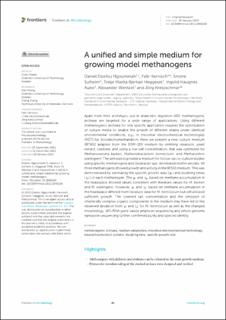| dc.contributor.author | Ngoumelah, Daniel Dzofou | |
| dc.contributor.author | Harnisch, Falk | |
| dc.contributor.author | Sulheim, Snorre | |
| dc.contributor.author | Heggeset, Tonje Marita Bjerkan | |
| dc.contributor.author | Aune, Ingvild Haugnes | |
| dc.contributor.author | Wentzel, Alexander | |
| dc.contributor.author | Kretzschmar, Jörg | |
| dc.date.accessioned | 2023-02-03T09:34:08Z | |
| dc.date.available | 2023-02-03T09:34:08Z | |
| dc.date.created | 2023-02-02T17:50:06Z | |
| dc.date.issued | 2023 | |
| dc.identifier.citation | Frontiers in Microbiology, 2023, 13, | en_US |
| dc.identifier.issn | 1664-302X | |
| dc.identifier.uri | https://hdl.handle.net/11250/3048195 | |
| dc.description.abstract | Apart from their archetypic use in anaerobic digestion (AD) methanogenic archaea are targeted for a wide range of applications. Using different methanogenic archaea for one specific application requires the optimization of culture media to enable the growth of different strains under identical environmental conditions, e.g., in microbial electrochemical technologies (MET) for (bio)electromethanation. Here we present a new culture medium (BFS01) adapted from the DSM-120 medium by omitting resazurin, yeast extract, casitone, and using a low salt concentration, that was optimized for Methanosarcina barkeri, Methanobacterium formicicum, and Methanothrix soehngenii. The aim was to provide a medium for follow-up co-culture studies using specific methanogens and Geobacter spp. dominated biofilm anodes. All three methanogens showed growth and activity in the BFS01 medium. This was demonstrated by estimating the specific growth rates ( μ ) and doubling times ( td ) of each methanogen. The μ and td based on methane accumulation in the headspace showed values consistent with literature values for M. barkeri and M. soehngenii. However, μ and td based on methane accumulation in the headspace differed from literature data for M. formicicum but still allowed sufficient growth. The lowered salt concentration and the omission of chemically complex organic components in the medium may have led to the observed deviation from μ and td for M. formicicum as well as the changed morphology. 16S rRNA gene-based amplicon sequencing and whole genome nanopore sequencing further confirmed purity and species identity. | en_US |
| dc.language.iso | eng | en_US |
| dc.publisher | Frontiers | en_US |
| dc.rights | Navngivelse 4.0 Internasjonal | * |
| dc.rights.uri | http://creativecommons.org/licenses/by/4.0/deed.no | * |
| dc.subject | specific growth rate | en_US |
| dc.subject | doubling time | en_US |
| dc.subject | bioelectrochemical systems | en_US |
| dc.subject | microbial electrochemical technology | en_US |
| dc.subject | medium adaptation | en_US |
| dc.subject | methanogenic archaea | en_US |
| dc.title | A unified and simple medium for growing model methanogens | en_US |
| dc.title.alternative | A unified and simple medium for growing model methanogens | en_US |
| dc.type | Peer reviewed | en_US |
| dc.type | Journal article | en_US |
| dc.description.version | publishedVersion | en_US |
| dc.rights.holder | © 2023 Dzofou Ngoumelah, Harnisch, Sulheim, Heggeset, Aune, Wentzel and Kretzschmar. | en_US |
| dc.subject.nsi | VDP::Bioteknologi: 590 | en_US |
| dc.subject.nsi | VDP::Biotechnology: 590 | en_US |
| dc.subject.nsi | VDP::Bioteknologi: 590 | en_US |
| dc.subject.nsi | VDP::Biotechnology: 590 | en_US |
| dc.source.pagenumber | 1-13 | en_US |
| dc.source.volume | 13 | en_US |
| dc.source.journal | Frontiers in Microbiology | en_US |
| dc.identifier.doi | 10.3389/fmicb.2022.1046260 | |
| dc.identifier.cristin | 2122537 | |
| dc.relation.project | EC/H2020/731101 | en_US |
| cristin.ispublished | true | |
| cristin.fulltext | original | |
| cristin.qualitycode | 2 | |

